Stimulus dependence of neuronal correlation in primary visual cortex of the macaque
- PMID: 15814797
- PMCID: PMC6725370
- DOI: 10.1523/JNEUROSCI.5106-04.2005
Stimulus dependence of neuronal correlation in primary visual cortex of the macaque
Abstract
Nearby cortical neurons often have correlated trial-to-trial response variability, and a significant fraction of their spikes occur synchronously. These two forms of correlation are both believed to arise from common synaptic input, but the origin of this input is unclear. We investigated the source of correlated responsivity by recording from pairs of single neurons in primary visual cortex of anesthetized macaque monkeys and comparing correlated variability and synchrony for spontaneous activity and activity evoked by stimuli of different orientations and contrasts. These two stimulus manipulations would be expected to have different effects on the cortical pool providing input to the recorded pair: changing stimulus orientation should recruit different populations of cells, whereas changing stimulus contrast affects primarily the relative strength of sensory drive and ongoing cortical activity. Consistent with this predicted difference, we found that correlation was affected by these stimulus manipulations in different ways. Synchrony was significantly stronger for orientations that drove both neurons well than for those that did not, but correlation on longer time scales was orientation independent. Reducing stimulus contrast resulted in a decrease in the temporal precision of synchronous firing and an enhancement of correlated response variability on longer time scales. Our results thus suggest that correlated responsivity arises from mechanisms operating at two distinct timescales: one that is orientation tuned and that determines the strength of temporally precise synchrony, and a second that is contrast sensitive, of low temporal frequency, and present in ongoing cortical activity.
Figures

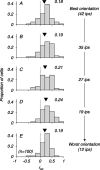




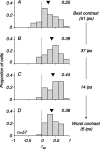


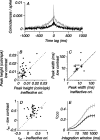
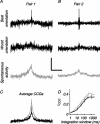
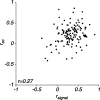
References
-
- Abbott LF, Dayan P (1999) The effect of correlated variability on the accuracy of a population code. Neural Comput 11: 91-101. - PubMed
-
- Aertsen AM, Gerstein GL, Habib MK, Palm G (1989) Dynamics of neuronal firing correlation: modulation of “effective connectivity.” J Neurophysiol 61: 900-917. - PubMed
-
- Amzica F, Steriade M (1995) Short- and long-range neuronal synchronization of the slow (<1 Hz) cortical oscillation. J Neurophysiol 73: 20-38. - PubMed
-
- Anderson JS, Carandini M, Ferster D (2000) Orientation tuning of input conductance, excitation, and inhibition in cat primary visual cortex. J Neurophysiol 84: 909-926. - PubMed
-
- Anderson T (1984) An introduction to multivariate statistical analysis. New York: Wiley.
Publication types
MeSH terms
Grants and funding
LinkOut - more resources
Full Text Sources
Other Literature Sources
Medical
